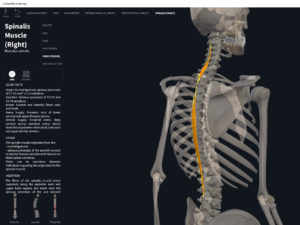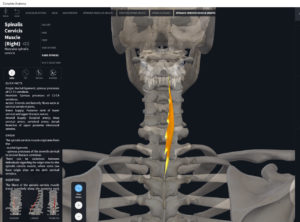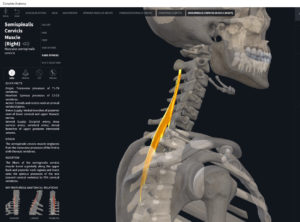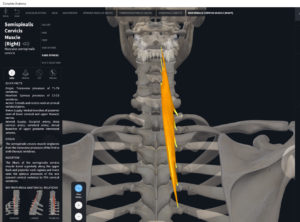Anatomy & Physiology: Muscles—Spinalis, of erector spinae group.
Structure.
- Spinalis Capitis
- Origin: ligamentum nuchae and spinous process of C7; considered to be the medial portion of semispinalis capitis.
- Insertion: spinous process of axis.
- Spinalis Cervicis
- Origin: inferior nuchal ligament and spinous process of C7.
- Insertion: spinous process of C2.
- Spinalis Thoracis
- Origin: spinous processes of T11-L2.
- Insertion: spinous processes of T4-T8.
Function.
- Concentric action: trunk and neck extension at spinal joints; lateral flexion of the trunk and neck at spinal joints.
- Reverse mover action: lower spine extension; lateral flexion of lower spine.
- Eccentric action: controls/restrains/slows flexion and contralateral flexion of trunk and neck.
- Isometric action: stabilization of the spine.
- Innervation: inferior cervical and thoracic spinal nerves.
- Arterial supply: dorsal branches of posterior intercostal and lumbar arteries.
Clinical Significance.
References
Biel, A. (2015). Trail guide to the body: A hands-on guide to locating muscles, bones and more.
Cedars-Sinai. (2018). Vertebrae of the spine. Retrieved from https://www.cedars-sinai.org/health-library/diseases-and-conditions/v/vertebrae-of-the-spine.html
Clark, M., Lucett, S., Sutton, B. G., & National Academy of Sports Medicine. (2014). NASM essentials of corrective exercise training. Burlington, MA: Jones & Bartlett Learning.
Jenkins, G., & Tortora, G. J. (2012). Anatomy and Physiology: From Science to Life, 3rd Edition International Stu. John Wiley & Sons.
Muscolino, J. E. (2017). The muscular system manual: The skeletal muscles of the human body.






